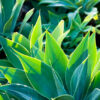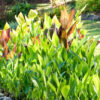Search Results for:
Proudly brought to you by:
Agave

Agave If you want bold, architectural plants in your garden, Peter Valder thinks that it’s hard to go past agaves. This fascinating group of perennial succulents occurs naturally in southern USA and Mexico. There are over 300 species, and many have dramatic, sword-shaped leaves with sharp teeth on the edges and fierce spines on the tips. Agaves produce tall flowering stems, but they can take from about 5 to 40 years to do so, depending on the spe...
read more
English Daisies
English daisies are trouble free and easy to grow, which is why they have been garden favourites since the early 16th century. Long ago they were given the name ‘day’s eye’, because the flowers close at dusk and open again at dawn. ‘Day’s eye’ became ‘daisy’, the name we now give to this and many other plants with similar flowers. Daisies appear to be single flowers, but each one is actually made up of numerous small flowers, or florets. The tubu...
read more
Eremophila nivea
Don looked at Eremophila nivea, an emu bush with silvery stems and leaves, and purple tubular flowers in spring and summer. This attractive, upright shrub grows to around 2m (6′) tall and 1.5m (5′) wide. Although perfectly adapted to survive in the drier parts of Australia, in humid coastal zones this plant is not easy to grow and is susceptible to fungal problems. Eremophila nivea grows best in a dry, sunny position, with perfect drainage. Once ...
read more
4 Seasons of Western Australian Flowers
Many people have been disappointed by Australian native plants in the past, but there is enormous potential to create superb gardens with natives. Don met nurseryman and author, George Lullfitz, who used spectacular Western Australian natives to demonstrate that you can have native plants in flower in the garden all year long. George thinks that there is no excuse for not growing native plants. They come in a wide range of colours in flowers and ...
read more
Coffee
Coffee Giuseppe and Rosa Bianca Carlo-Stella have a fabulous garden filled with vegetables, herbs and fruit. They even have a mini coffee plantation in their backyard! Giuseppe and Rosa harvest the red coffee berries and extract the seed, which they use to make their own delicious coffee. Plant details Common name: Coffee Botanic name: Coffea arabica Description: Bushy, evergreen tree which may reach about 5m x 3m (15′ x 10′) when mature. It has ...
read more
Canna Lilies

If you want a bright, happy, tropical-style garden but you don’t live in the tropics, think about planting canna lilies. Cannas are undergoing a new wave of popularity now that warm colours and bold foliage are back in style. In our segment Don visited canna grower Anne Glancy, who has been collecting, identifying and researching the history of cannas for the last 20 years. Anne has a garden and mail order nursery in Melbourne, where she grows ov...
read more
Heliotrope
Heliotrope or cherry pie (Heliotrope arborescens) is an evergreen shrub from tropical Peru. It grows to around 1m (3′) tall and 1.5m (5′) wide. The foliage is dark green and crinkled, with golden (‘Aurea’) or purple leaved (‘Lord Roberts’) cultivars available. From early spring to late summer it produces clusters of violet to mauve flowers with a heady, vanilla fragrance. Heliotrope grows best in the warmer parts of Australia. Heliotrope likes we...
read more
Hibiscus

Hibiscus The Hibiscus Although widely known as Hawaiian hibiscus, Hibiscus rosa-sinensis was probably native to Southern China and south-east Asia, then spread to the Pacific Islands long before Europeans reached that part of the world. Today it is very popular as an ornamental plant in most warm countries, and the original red flowered plant has undergone tremendous development. Hundreds of cultivars are now available, with double and semi-doubl...
read more
Holly
Don looked at holly, a native of Europe, north Africa and western Asia. In the Northern Hemisphere holly is associated with Christmas time, because it produces bright red berries around December. In the Southern Hemisphere the berries are produced between May and August. So if Australians want holly for Christmas they have to travel to Europe, use plastic holly, or celebrate ‘Christmas in July’. English holly (Ilex aquifolium) This large, evergre...
read more
Lapagerias
Lapagerias The stunning flower of the lapageria resembles an exotic tropical orchid, hand-carved from wax. Surprisingly, the lapageria is not a tropical plant. It is native to the cool, mountainous region of southern Chile, where it is known by its Araucanian Indian name, ‘El Copihue’. The lapageria is the National Flower of Chile. Plant details Common name: Chilean bellflower Botanic name: Lapageria rosea Description: An evergreen, twining climb...
read more
Liriope Muscari
Teena Crawford is co-host of radio program ‘Smart Gardening’ on Melbourne’s 3AW. Two years ago she planted her front yard with Liriope muscari as a lawn substitute. On the day Burke’s Backyard visited, Teena’s ‘lawn’ was in full flower, and looked so spectacular that passers-by were stopping to admire it. Plant details Common name: Lily turf Botanic name: Liriope muscari Description: An evergreen perennial to about 60cm (24″) tall, and 45cm (18″)...
read more
Mai-Ko Hydrangeas
Mai-Ko Hydrangeas Hydrangeas were discovered in Japanese forests by early European explorers, who took plants back to Europe and used them to develop the hydrangeas we know and love today. Japanese grower/breeder Hiroshi Ebihara decided to import ‘European’ hydrangeas back to Japan in 1970. His breeding program resulted in the production of compact hydrangeas with large, multi-coloured flowers. In Australia they are known as the ‘Mai-Ko’ series o...
read more




